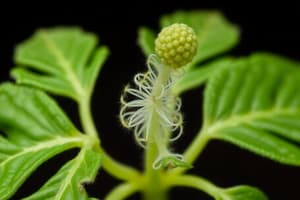Podcast
Questions and Answers
What type of natural selection favors individuals at one extreme of a trait distribution?
What type of natural selection favors individuals at one extreme of a trait distribution?
- Sexual Selection
- Disruptive Selection
- Stabilizing Selection
- Directional Selection (correct)
Which of the following accurately describes a characteristic unique to vascular plants?
Which of the following accurately describes a characteristic unique to vascular plants?
- They depend entirely on diffusion for nutrient transport.
- They lack true stems and roots.
- They possess vascular tissues to transport materials. (correct)
- They reproduce using spores.
What is the primary function of the palisade cells in leaves?
What is the primary function of the palisade cells in leaves?
- Photosynthesis (correct)
- Gas exchange
- Providing structural support
- Water transpiration
What type of plant tissue is primarily responsible for transport?
What type of plant tissue is primarily responsible for transport?
Which type of reproductive barrier occurs before fertilization?
Which type of reproductive barrier occurs before fertilization?
What process describes the movement of water from the roots to the leaves in plants?
What process describes the movement of water from the roots to the leaves in plants?
Which hormone is primarily involved in promoting cell division and delaying aging in plants?
Which hormone is primarily involved in promoting cell division and delaying aging in plants?
Which characteristic is NOT true of monocots?
Which characteristic is NOT true of monocots?
Which of the following correctly illustrates the function of xylem in vascular plants?
Which of the following correctly illustrates the function of xylem in vascular plants?
What is the main role of guard cells in plant leaves?
What is the main role of guard cells in plant leaves?
What type of evolution occurs when two species evolve similar traits due to similar environmental pressures?
What type of evolution occurs when two species evolve similar traits due to similar environmental pressures?
Which plant part is responsible for capturing light energy during photosynthesis?
Which plant part is responsible for capturing light energy during photosynthesis?
Which type of plant growth results in an increase in the diameter of the plant?
Which type of plant growth results in an increase in the diameter of the plant?
What is the primary role of ethylene in plants?
What is the primary role of ethylene in plants?
Which type of symmetry is exhibited by animals like starfish?
Which type of symmetry is exhibited by animals like starfish?
What is the primary difference between microevolution and macroevolution?
What is the primary difference between microevolution and macroevolution?
Which of the following statements is true regarding Darwin's observations?
Which of the following statements is true regarding Darwin's observations?
Which factor does NOT affect allele frequencies in a population?
Which factor does NOT affect allele frequencies in a population?
Which structure in viruses is responsible for protecting their genetic material?
Which structure in viruses is responsible for protecting their genetic material?
What mechanism of speciation involves geographic isolation?
What mechanism of speciation involves geographic isolation?
Which type of selection favors individuals with extreme traits?
Which type of selection favors individuals with extreme traits?
In the context of evolution, what does 'adaptive radiation' describe?
In the context of evolution, what does 'adaptive radiation' describe?
Which of the following is a component of the lytic cycle of viral reproduction?
Which of the following is a component of the lytic cycle of viral reproduction?
What is the primary function of the liver in the human digestive system?
What is the primary function of the liver in the human digestive system?
Which of the following adaptations involves changes in biochemical functions of organisms?
Which of the following adaptations involves changes in biochemical functions of organisms?
Which type of pre-zygotic barrier occurs when two species breed at different times?
Which type of pre-zygotic barrier occurs when two species breed at different times?
What is the study of the structure of body parts called?
What is the study of the structure of body parts called?
Which mechanism is responsible for the genetic changes within populations due to chance events in small populations?
Which mechanism is responsible for the genetic changes within populations due to chance events in small populations?
Flashcards
What is the classification system?
What is the classification system?
A system for classifying organisms based on shared characteristics. It uses a hierarchical system with seven levels: Domain, Kingdom, Phylum, Class, Order, Family, Genus, Species.
Explain binomial nomenclature.
Explain binomial nomenclature.
The process of naming organisms using a two-part system.
Define biological evolution.
Define biological evolution.
The process by which genetic changes occur in a population over time.
What is microevolution?
What is microevolution?
Signup and view all the flashcards
What is macroevolution?
What is macroevolution?
Signup and view all the flashcards
What is mimicry?
What is mimicry?
Signup and view all the flashcards
What is biogeography?
What is biogeography?
Signup and view all the flashcards
What is the fossil record?
What is the fossil record?
Signup and view all the flashcards
What are homologous structures?
What are homologous structures?
Signup and view all the flashcards
What are analogous structures?
What are analogous structures?
Signup and view all the flashcards
What is genetic drift?
What is genetic drift?
Signup and view all the flashcards
What is gene flow?
What is gene flow?
Signup and view all the flashcards
Define natural selection.
Define natural selection.
Signup and view all the flashcards
Define sexual selection.
Define sexual selection.
Signup and view all the flashcards
What is speciation?
What is speciation?
Signup and view all the flashcards
Evolution
Evolution
Signup and view all the flashcards
Mutations
Mutations
Signup and view all the flashcards
Genetic Drift
Genetic Drift
Signup and view all the flashcards
Gene Flow
Gene Flow
Signup and view all the flashcards
Non-random Mating
Non-random Mating
Signup and view all the flashcards
Natural Selection
Natural Selection
Signup and view all the flashcards
Directional Selection
Directional Selection
Signup and view all the flashcards
Stabilizing Selection
Stabilizing Selection
Signup and view all the flashcards
Disruptive Selection
Disruptive Selection
Signup and view all the flashcards
Sexual Selection
Sexual Selection
Signup and view all the flashcards
Speciation
Speciation
Signup and view all the flashcards
Reproductive Isolation
Reproductive Isolation
Signup and view all the flashcards
Pre-zygotic Barriers
Pre-zygotic Barriers
Signup and view all the flashcards
Post-zygotic Barriers
Post-zygotic Barriers
Signup and view all the flashcards
Convergent Evolution
Convergent Evolution
Signup and view all the flashcards
Study Notes
Grade 11 University Biology Study Notes
- Unit 1 - Plants: Structure and Function: Introduces plants, their characteristics, adaptation to land, vascular and non-vascular plants, seed-producing plants and flowering plants. Includes details on plant tissues, plant growth, water transport, and plant hormones. Also covers roots, stems, and leaves, along with their structure and functions.
Unit 1 - Plants: Structure and Function - Subtopics
- Introduction to Plants: Contains 5 plant characteristics, plant adaptation to land and non-vascular and vascular plants.
- Adapting on land: Describes how early plant-like protists adapted to life on land - including protective measures against drying out, ways to transport water, nutrients and wastes.
- Non-vascular Plants: Details about the absence of vascular systems in these plants — how they are structured, the methods used for moving water and nutrients, and reproductive strategies are covered.
- Vascular Plants: Explains the vascular plant structure, along with vascular tissue types and functions. Covers seeds, producing plants, and flowering plants.
- Seed Producing Plants: Focuses on seeds as a strategy for reproduction, their structure and development. Includes seed adaptations - seed dispersal and methods.
- Flowering Plants: Explains the flower structure and its role in reproduction.
- Roots and Stems: Explains the roots, their types and functions, and the stem types and functions; covering development and 4 zones of the roots.
- Leaves: Four main functions, deciduous leaves/needles, leaf structure, and plant tissue.
- Plant Tissues: Describes dermal, ground, and vascular tissues. Includes factors of plant growth
- Transport of Water and Minerals in Xylem: Looks at the transpiration-cohesion-tension theory, and the involvement of hydrogen bonding for water transport.
- Plant Hormones: Explains the roles of plant hormones in regulating plant growth and development, with 4 main types: gibberellins, cytokinins, ethylene, and abscisic acid. Includes plant tropism and response to stimulus.
Unit 2: Genetic Processes 2A
- Introduction to Genetics: Explains genetics' role in inheritance, DNA, and chromosome structure. Includes the concept of genes, traits, and haploid/diploid cells along with the order of nitrogen bases for organism uniqueness.
- Genetics and Inheritance: Focuses on how traits are passed from one generation to another.
- DNA and Chromosomes: Explores DNA structure, characteristics and function using examples like its unique double helix shape. Explores chromosomes as coiled DNA.
- Genes and Traits: Defines genes as short segments controlling trait expression and instructions to make proteins for cellular structure and enzymes. Genetic traits in the form of proteins.
- Haploid and Diploid Cells: Describes haploid (single set of chromosomes) and diploid (paired set of chromosomes) cells, their roles in reproduction (mitosis/meiosis).
- Cell Cycle and Meiosis: Explains interphase stages (G1, S, G2), Mitosis (prophase, metaphase, anaphase, telophase and cytokinesis), and the process. Summarizes the differences between mitosis and meiosis.
- DNA structure: Describes the molecule in detail, including nucleotides, base pairings, and anti-parallel nature.
- Karyotypes: explains the use of karyotypes to visualize chromosomes, diagnose genetic disorders, and analyse gene variation.
- Meiosis: Details the stages and outcomes of meiosis, particularly how it reduces the chromosome number, and the generation of genetic variation.
- Gametogenesis, Genetic Variation and Mutations: Describes the formation of gametes. Covers meiosis, different forms of gametogenesis, and genetic variation through mutations. Explains the different types of mutations and consequences.
- Inheritance Patterns: Discusses various patterns, such as dominant, recessive, co-dominance, incomplete dominance, and sex-linkage.
- Simple Inheritance Patterns and Pedigrees: explains autosomal dominance, recessiveness, inheritance, and sex-linked patterns and how to show on a pedigree diagram.
- Multiple Alleles and Polygenetic Inheritance: Explains how multiple alleles result in multiple phenotypes and how they affect variations. Looks at the concept of blood types and the immune system in relation to these variations.
Unit 2B: Inheritance Patterns
- Mendelian Genetics Terminology: Explains basic vocabulary and concepts
- Mendel’s Laws: Explains important concepts in heredity such as co-dominance, sex-linkage, and sex-linked traits in terms of how they are inherited. Includes concepts of monohybrid and dihybrid crosses, determining genotypes and phenotypes using punnett squares.
- Co-dominance, Incomplete Dominance, Sex Linkage: Details how these patterns of inheritance differ from simple dominant/recessive patterns.
Unit 3: Diversity of Living Things
- Taxonomy: Covers classification of living organisms to show how closely related species are, the methods for classification, and types of evidence.
- Binomial Nomenclature: Details the universal system for naming organisms, using scientific names for organisms and genus/species. Explores how to use these names.
- Dichotomous Keys: Explains how to use dichotomous keys for identifying organisms using branching methods.
Unit 4: Evolution
- Introduction to Evolution: Introduces microevolution and macroevolution as types of evolution and the changes in populations.
- Biological Evolution: Defines and provides the definition of the term
- Darwin and the Theory of Evolution: Examines Darwin's observations, influential figures, pre-Darwinian ideas about evolution, and the theory itself.
- Scientific Contributions to Theory of Evolution: Covers significant contributors to the theory and their observations, as well as major concepts like natural selection and uniformitarianism relating to ideas of the natural world.
- Evidence for Evolution: Presents the key pieces of evidence — biogeography, fossil records, comparative anatomy, comparative embryology, and molecular biology — that support the theory of evolution.
- Evolutionary Adaptations: Types of Adaptations, including structural, physiological and behavioural adaptations and how they enhance fitness, survival and reproduction.
- Mechanisms Affecting Populations: Explains mechanisms leading to evolution and changes in allele frequencies in populations, like mutations and genetic drift. Expands on genetic drift including concepts for population sizes and the "bottleneck effect."
- Natural and Sexual Selection: Explains natural selection through Darwin's five points, with subtypes (directional, stabilizing, disruptive), and how it influences genetic variability overtime. Explains sexual selection, its role in mate choice and reproductive success.
Unit 5: Internal Systems: Structure and Function
- Introduction to Internal Body Systems: Defines organisms, tissues, organs and organ systems, and their relationship for maintaining homeostasis. Defines Anatomy and Physiology as specific study methods.
- Organ Systems: Examines how specific organ systems of an organism work together to maintain homeostasis and perform complex functions like the internal body systems relating to the digestive and respiratory.
- Human Digestive System: Examines the parts of the human digestive system and their respective functions and interactions for digestion. Includes the mechanical and chemical aspects of digestion and roles of enzymes.
- Human Respiratory System: Examines the structures and functions of the respiratory system for gas exchange, through breathing/ventilation, external and internal respiration and how cells use this energy.
- Human Circulatory System: Describes the heart and blood vessels, circulation patterns, and the role of blood in transporting nutrients, wastes, and gases. Covers the structure of the heart and types of blood vessels in relation to the circulatory system.
Studying That Suits You
Use AI to generate personalized quizzes and flashcards to suit your learning preferences.




